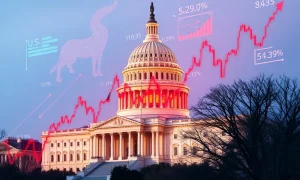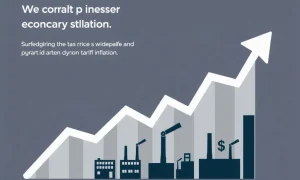The global business landscape often faces unexpected challenges. Currently, the liquor industry confronts a formidable one: tariffs. These import duties are poised to inflict a staggering blow. Experts predict that the cumulative cost to the liquor industry could exceed $2 billion in lost sales. This represents a significant financial setback for a vibrant global sector. Businesses and entrepreneurs across the supply chain must understand these economic shifts. They will directly affect their operations and profitability.
Understanding the Impact of Liquor Industry Tariffs
Tariffs are taxes levied on imported goods. They increase the cost of foreign products. In the context of the liquor industry, these duties have been applied to various alcoholic beverages. This includes whiskies, wines, and brandies. The United States and the European Union have been key players in this trade dispute. Consequently, these measures have created substantial market volatility.
The origin of these tariffs often lies in broader trade disagreements. For instance, disputes over aircraft subsidies led to retaliatory tariffs. The liquor industry became an unfortunate casualty. These duties directly increase the price of imported goods. This makes them less competitive in the market. As a result, consumers face higher costs. Demand for these products can then decline significantly.
Initial estimates of the financial toll are alarming. Industry bodies have diligently tracked the impact. They report substantial revenue declines. Many companies, especially smaller ones, struggle to absorb these extra costs. Therefore, the ripple effect extends throughout the entire value chain. It affects producers, distributors, and retailers alike.
The Ripple Effect: How Liquor Industry Tariffs Hurt the Supply Chain
The supply chain for alcoholic beverages is complex. It involves numerous stages. Each stage faces unique challenges from the imposition of liquor industry tariffs. Consider the journey from distillery to consumer. Tariffs disrupt every step.
- Importers Bear the Brunt: Importers must pay the additional tariff fees. These costs are often passed on to distributors. This increases the overall price of the product.
- Distributors Face Reduced Demand: Higher prices at the import stage lead to higher wholesale prices. Distributors then find it harder to sell products to retailers. Their sales volumes typically decrease.
- Retailers See Lower Foot Traffic: Increased consumer prices can deter purchases. Retailers may experience reduced sales of specific imported products. They might also shift focus to untariffed alternatives.
Moreover, the impact is not limited to sales figures. Companies may also reduce their workforce. This happens as they try to cut costs. Supply chain efficiency also suffers. Businesses often re-evaluate their sourcing strategies. They might seek new, untariffed markets. However, this process takes time and resources. Ultimately, it disrupts established trade relationships. The overall economic contraction within the sector becomes evident.
Specific Sectors Within the Liquor Industry Facing Challenges
Not all segments of the liquor industry are affected equally. Certain categories of alcoholic beverages bear a disproportionate burden from liquor industry tariffs. Understanding these specifics highlights the targeted nature of the economic pain.
For example, single malt Scotch whisky faced significant tariffs. So did certain French wines and brandies. These products are often high-value. They also have established global markets. Consequently, the tariffs hit their sales hard. Conversely, domestic products or those from untariffed regions might see a temporary advantage. However, this does not compensate for the overall market shrinkage.
Small and medium-sized enterprises (SMEs) are particularly vulnerable. They often lack the financial reserves of larger corporations. Absorbing increased costs or navigating complex new trade rules becomes challenging. Many smaller distilleries, wineries, and importers struggle to stay afloat. They face difficult decisions about pricing and market presence. This situation threatens their long-term viability. Furthermore, it impacts local economies where these businesses operate.
The geographical impact is also notable. European producers of targeted spirits and wines have seen significant export declines to the U.S. market. Similarly, American whiskey producers faced retaliatory tariffs from the EU. This created a two-way street of economic damage. Therefore, the global nature of the liquor industry means these tariffs have far-reaching consequences beyond any single border.
Beyond Sales: Long-Term Consequences of Liquor Industry Tariffs
The immediate $2 billion sales loss is only one facet of the problem. Liquor industry tariffs also pose significant long-term threats. These threats extend far beyond direct revenue impacts. They can reshape market dynamics and investment patterns for years to come.
Firstly, market share shifts become apparent. Consumers may opt for untariffed alternatives. This can lead to a permanent change in purchasing habits. Once a consumer switches brands, they might not return. Even if tariffs are lifted, regaining lost market share is difficult. This creates a lasting disadvantage for affected products.
Secondly, investment slows down. Companies become hesitant to invest in new production facilities or market expansion. Uncertainty about future trade policies deters long-term planning. This lack of investment can stifle innovation. It also prevents the creation of new jobs. Economic growth within the sector consequently stagnates.
Thirdly, brand reputation can suffer. Higher prices might make consumers perceive a product as less valuable. Some brands may also struggle with distribution issues. This leads to reduced availability. Such problems can damage a brand’s image over time. Rebuilding trust and market presence requires considerable effort and resources.
Finally, the tariffs strain international trade relations. They create an environment of mistrust and unpredictability. This makes it harder for businesses to plan and grow globally. The overall effect is a less interconnected and less efficient global liquor market. This benefits no one in the long run.
Industry Responses and Calls for Action Against Liquor Industry Tariffs
The liquor industry has not remained silent. Key industry associations and individual companies have actively campaigned against these tariffs. Their collective voice highlights the severe economic damage. They also advocate for policy changes.
Lobbying efforts are a primary response. Industry groups engage with governments and policymakers. They present data on job losses and revenue declines. They argue that tariffs harm businesses and consumers. Their message emphasizes the need for a swift resolution. They seek the removal of these punitive duties.
Trade associations have issued numerous statements. Organizations like the Distilled Spirits Council of the United States (DISCUS) and SpiritsEUROPE have been vocal. They regularly publish reports detailing the financial devastation. They also highlight the disproportionate impact on small businesses. These reports serve as crucial evidence in their advocacy efforts.
Proposed solutions often center on negotiation. The industry urges governments to return to the negotiating table. They advocate for a diplomatic resolution to underlying trade disputes. They believe that tariffs are not an effective long-term solution. Instead, they disrupt legitimate trade. They also harm innocent industries. The goal is always to restore free and fair trade conditions. This would allow the liquor industry to thrive once more.
Navigating the Future: Strategies for the Liquor Industry Amidst Tariffs
Despite the challenges, the liquor industry is resilient. Companies are actively developing strategies to mitigate the impact of liquor industry tariffs. These strategies aim to ensure business continuity and long-term sustainability. Adaptability is key in this uncertain environment.
One common strategy is market diversification. Businesses explore new export markets not affected by tariffs. This helps spread risk. It also opens up new revenue streams. However, entering new markets requires significant investment and research. It also involves understanding new regulatory frameworks.
Supply chain optimization is another crucial approach. Companies may look for alternative suppliers or production locations. This can help avoid tariffed routes. It might also involve streamlining logistics to reduce costs elsewhere. Efficiency gains can help offset some of the tariff burden. This requires careful planning and execution.
Cost management is always a priority. Businesses are scrutinizing every expense. They seek areas where they can cut costs without compromising quality. This might involve renegotiating contracts with suppliers. It could also mean optimizing internal processes. The goal is to maintain profitability in a high-cost environment.
Finally, some companies seek government support. They may apply for grants or relief programs. These programs aim to help businesses affected by trade disputes. While not a complete solution, such support can provide temporary relief. It helps businesses weather the storm until a resolution is found.
The path forward for the liquor industry remains challenging. However, proactive measures and continued advocacy offer hope. The collective efforts of businesses and associations are vital. They strive to overcome the significant hurdle posed by these tariffs. Ultimately, a return to open and fair trade policies is the desired outcome. This would allow the liquor industry to recover its lost sales and resume its growth trajectory.
Frequently Asked Questions (FAQs)
Q1: What are liquor industry tariffs?
Liquor industry tariffs are taxes imposed by one country on alcoholic beverages imported from another country. These duties increase the cost of imported spirits, wines, and beers, making them more expensive for consumers and businesses in the importing nation. They are often used as a tool in broader trade disputes between nations.
Q2: How much money is the liquor industry expected to lose due to these tariffs?
Current estimates suggest that the liquor industry stands to lose over $2 billion in sales. This figure reflects the cumulative impact of various tariffs imposed on different categories of alcoholic beverages across key international markets, leading to reduced demand and higher operational costs for businesses.
Q3: Which types of alcoholic beverages are most affected by these tariffs?
Specific categories heavily impacted include certain types of whiskies (like single malt Scotch and American whiskey), French wines, and brandies. These products are often high-value exports from regions involved in trade disputes, making them prime targets for retaliatory tariffs.
Q4: How do tariffs affect small businesses in the liquor industry?
Small and medium-sized enterprises (SMEs) are particularly vulnerable. They often lack the financial reserves to absorb increased import costs or the resources to navigate complex new trade regulations. This can lead to reduced profitability, difficulty competing, and in some cases, business closures, impacting local economies.
Q5: What actions is the liquor industry taking to combat these tariffs?
The liquor industry is actively engaging in lobbying efforts with governments, publishing reports on the economic damage, and advocating for the removal of tariffs. Industry associations like DISCUS and SpiritsEUROPE are urging policymakers to return to diplomatic negotiations to resolve underlying trade disputes and restore free trade conditions.
Q6: What long-term consequences might these liquor industry tariffs have?
Beyond immediate sales losses, long-term consequences include shifts in market share towards untariffed alternatives, reduced investment in new production and market expansion, potential stagnation of innovation, and damage to brand reputations. The tariffs also strain international trade relations, creating an unpredictable environment for global commerce in the sector.
























